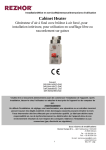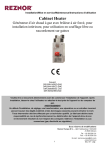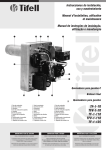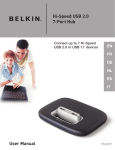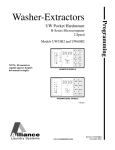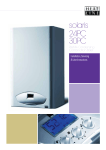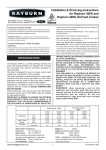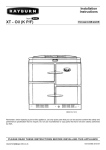Download BENSON HEATING LTD CVO 100 Technical data
Transcript
OIL FIRED UNIT HEATER 1 OIL FIRED UNIT HEATER CONTENTS Compliance notices 3 Certificates of Conformity 4 General Information 4 Delivery Checks 5 Warranty 5 Heater Dimensions 6 Suspension Details 7 Wall Mounting Dimensions 8 Installation 9 Air Supply 10 Fuel System 10 Flue System 12 Commissioning Pre test 13 Commissioning Ignition 14 Servicing 15 Electrical Supply 16 Wiring Diagrams 16-18 Technical Data 19 2 OIL FIRED UNIT HEATER Section B Warranty Section C User Instructions 19-21 Benson Heating Ltd, to ensure that they are familiar with the appropriate information/manuals, supplied by the manufacturer, and that they are suitably aware of the purpose of the manuals and the safety instructions. In addition, operators must be suitably trained in the use of the appliance so as to ensure its continued safe and efficient use. Benson Heating Ltd has a commitment to continuous improvement, and therefore reserves the right to amend or change the specification of the Unit Heater range subject to compliance with the appropriate European, National, and Local Regulations. 1.0 Compliance notices The following information is relevant to the Benson Heating Ltd Oil Fired Unit Heater range (OUHA) and (OUHC) manufactured for. These heaters are manufactured within a strictly controlled quality environment within the parameters of ISO 9002. The OUHA (C) Heater range has been tested and assessed for compliance with the following European Directives. Machinery Directive (89/392/EEC) Low Voltage Directive (73/23/EEC & 93/68/EEC) Electromagnetic Compatibility Directive (89/336/EEC & 91/31/EEC) Product Liability Directive (65/374/EEC) Contained within the text of the manual, the words 'Caution' and 'Warning' are used to highlight certain points. Caution is used when failure to follow or implement the instruction(s) can lead to premature failure or damage to the heater or its component parts. The manufacturer has taken reasonable and practical steps to ensure that Oil Fired Unit Heaters are safe and without risk when properly used. These heaters should therefore only be used in the manner and purpose for which they were intended, and in accordance with the recommendations detailed herewith. Warning is used when failure to heed or implement the instruction(s) can lead to not only component damage, but also to a hazardous situation being created where there is a risk of personal injury. The heaters have been designed, manufactured, assembled, inspected, and tested, with safety and quality in mind, there are certain basic precautions which the installer and user should be aware of, and they are strongly advised to read the appropriate sections of the information pack accompanying the heater, prior to installation or use. The OUHA ( C ) Range conform to the following harmonized standards; BS EN 292 - Part 1 : 1991 Safety of Machinery - Basic Concepts, General Principles for Design Basic terminology, methodology Benson Heating supports all new products being supplied to their customers with a comprehensive information pack; this clearly defines mandatory instructions for the safe installation, use, and maintenance, of the appliance(s). BS EN 292 - Part 2 : 1991 Safety of Machinery - Basic Concepts, General Principles for Design Technical Principles and Specifications BS EN 60204 - Part 1 : 1993Safety of Machinery - Electrical Equipment for Machines Specification for General Where proprietary items are incorporated into Benson Heating Ltd products, detailed information and instructions are also provided as part of the information pack. Requirements BS EN 60335 - Part 1 : 1988 Safety of Household and Similar Electrical Appliances General Requirements It is the responsibility of the installer, owner, user, or hirer, of such products supplied by 3 OIL FIRED UNIT HEATER BS EN 55014 - 1993 Limits and methods of measurement of radio disturbance characteristics of electrical motor-operated and thermal appliances for household and similar purposes, electrical tools and similar electric apparatus manufacturers recommendations may constitute a hazard. Note To ignore the warning and caution notices, and to ignore the advice from the manufacturer on installation, commissioning, servicing, or use, will jeopardise any applicable warranty, moreover, such a situation could also compromise the safe and efficient running of the appliance itself, and thereby constitute a hazard. The installation of the appliance must meet all the relevant European, National, and Local Regulation criteria. BS EN 50165 - 1995 Electrical Equipment of non-electric heating appliances for household and similar purposes, safety requirements 1.1 Certificates of conformity Certificates are available from the Quality Control Department at Benson Heating Ltd Prior to installation the following points should be considered; 1.2 General product information a) The position of the heater for the efficient distribution and circulation of warm air The unit heater models have an output range from 100,000 Btu to 339,000 Btu. b) The position of the heater relative to the route of the flue Each heater must be connected to its own individual open flue. c) The position of the heater relative to the supply of fuel Each heater is fitted with a forced draught burner which has been test fired and pre-set prior to despatch. The safety functions of the burner are by way of a fully sequential control box fitted to the burner. d) The position of the heater relative to the electrical services, and if appropriate, any additional controls. Note Neither asbestos nor soft soldered joints are used in the construction or manufacture of the Benson Heating Ltd range of Unit Heaters. The materials selected for use can withstand the mechanical, chemical, and thermal stresses which they will be subject to during foreseen normal use when installed in accordance with the manufacturers recommendations. e) The position of the heater relative to the supply of fresh air f) The position of the heater relative to service and maintenance requirements Caution The heater must not be installed within an area where the conditions are unsuitable, e.g. where the atmosphere is highly corrosive, has a high degree of salinity, or where high wind velocities may affect burner operation. Suitable protection should be provided for the appliance when it is located in a position where it may be susceptible to external mechanical damage from; for example, fork lift trucks, overhead cranes etc. 1.3 General requirements Caution Ensure that the fuel supply is in accordance with the manufacturer's recommendations and is as stated on the appliance data plate. Installation, commissioning, and servicing must only be carried out by appropriately qualified and competent persons. Warning Unauthorised modifications to the appliance, or departure from the manufacturers guidance on intended use, or, installation contrary to the 4 OIL FIRED UNIT HEATER 1.4 Delivery and pre-installation checks f) The main electrical supply input to the heater has been interrupted during the heating mode The heater is supplied wrapped in heavy duty protective polythene. On receipt of the heater, the following checks should be carried out; (a Model is as per order (b That it is undamaged (c That it is suitable for the fuel supply g) The heater has been subject to and affected by the ingress of water in any form h) The heater is not operated at the rating(s) laid down in the manufacturers technical specifications (d That it is suitable for the electrical supply If any of the points are not satisfied then contact should be made with the sales office at Benson Heating Ltd as soon as possible by telephoning 01547 528534. in the case of claims for damage, this must be reported in writing within 24 hours of delivery, in order to comply with insurance criteria. i) The heater has not been operated or used within the normal scope of its intended application 1.5 Warranty All warranty claims must contain the following information to enable processing to take place; (1) Heater model (2) Heater serial number (3) Order reference/date of order, together with full installation details (name and address) (4) Details or symptoms of fault (5) Installers name and address. j) The manufacturer's recommended minimum service requirements have not been complied with The heater is supplied with a 2 year warranty comprising of the following 1 year parts and labour 1 year parts only. In addition to this there is also a 10 year time related warranty on the combustion chamber. The warranty commences from the date of dispatch from the manufacturer, and is subject to the terms detailed within the Harry Taylor Ltd 'conditions of business'. Faulty parts must be returned to the Benson Heating Ltd Spares Department, the address of which is provided at the back of this manual. Any such parts will undergo inspection to verify the claim. Replacement parts supplied prior to this may be charged, and a credit supplied upon subsequent validation of the warranty claim. Consumable items are specifically not included within the scope of the warranty. The warranty may be invalidated if a) The warranty registration and commissioning card has not been completed and returned to Harry Taylor Ltd b) The installation is not in accordance with the general requirements of this manual Notification is required immediately a fault is suspected. The manufacturer will not accept responsibility for any additional damage that has been caused, expense incurred, or consequential loss resulting from any failure of the heater(s) c) The flue arrangement and air supply for the heater are not in accordance with the manufacturers recommendations, codes of practice, or similar standards d) Air flow through the heater is not in accordance with the manufacturers technical specifications e) Internal wiring on the heater has been tampered with or Unauthorised service/repairs undertaken 5 OIL FIRED UNIT HEATER 6 OIL FIRED UNIT HEATER 7 OIL FIRED UNIT HEATER 8 OIL FIRED UNIT HEATER Suspended free blowing Unit Heaters are at their most effective when located as close to the working area as possible. However care should be exercised to avoid directing the discharged air directly onto the occupants of the area to be heated. 2.0 Installation Note It is a requirement that only qualified and competent personnel may undertake installation commissioning and servicing of OUHA ( C )Range Heaters. Where the passage of cold air causes problems (e.g by entrances, loading bays etc) it is considered favourable if the heater is positioned so as to discharge towards or across the cold air source from a distance from 1.5m - 6m dependent upon the size of the entrance and the air throw characteristics of the heater. On exposed walls heaters should be positioned so as to discharge towards, or along the length of the exposed wall. In areas where it is proposed that more than one heater is to be installed, a general scheme of circulation should be drawn up and maintained, thereby offering the best heat distribution. Air pressure within the area heated and the outside air pressure must remain the same, factors influencing this would be the presence of extraction systems, ventilation systems, and various types of process plant. OUH 240/340 models can be installed to allow the fans to work in opposite directions . This enables the heater to be installed centrally in the area to be heated and allows warm air to be discharged to both the front and rear of the heater Warning All of the basic criteria must be satisfied prior to commencing installation and commissioning, additionally, the Unit Heater must be positioned and installed so as to comply with all the relevant standards and guide lines as well as meeting national and local fire regulations and insurance criteria, especially if it is proposed that the heater is to be installed within a special risk area (e.g. proximity to where petrol engined vehicles are stored or parked, where cellulose spraying takes place, where woodworking machinery is operated, etc,). Indirect fired heaters must not be located in hazardous areas, however, it is permissible for the heater to supply air to such areas. The heater must not be installed within an environment where there is a high concentration of chlorides, fluorides, salts, or other aggressive or volatile chemicals/compounds. Nor should the heater be positioned where the burner could be adversely affected by high winds or draughts. The heater must be installed so that it is level. Supports for the heater must be sufficiently robust to withstand the weight of the heater and any ancillary equipment. Any combustible material adjacent to the heater or flue system must be so placed or shielded so that its surface temperature does not exceed 65C The location chosen for the heater must allow for the fitting of an effective flue system. The location must also allow for adequate clearance for the air supply, return air circulation, oil supply, electrical supply, whilst also providing good and safe working access. 9 OIL FIRED UNIT HEATER 2.1 Air supply If the heater is to be installed within its own separate building or plant room, the above details do still apply, as does the requirement for minimum space. Provision must be made for the existence of an air supply for both combustion and ventilation. It is a requirement that the area where the air heater is located must have a permanent air vent of negligible resistance direct to the outside air. Such air vents must be positioned so as not to become blocked or flooded, nor should they be placed so as to introduce undesirable matter (e.g. flammable, volatile, or aggressive chemicals/compounds or potentially hazardous or harmful substances) either direct from the outside, or through their proximity to an adjacent extraction system. The criteria necessary for establishing the minimum size of natural vents is detailed as follows; Position of vent Low level inlet (< 60kW) ( >60kW) 3.0 Fuel Three methods of fuel supply can be used to supply fuel to the heaters (a) Two pipe system (b) Gravity Feed (c) Pressurised ring main Two pipe system This is used where the oil storage tank is lower than the pump. Access for the fuel feed to the burner should be via a suitable tapping made in the top of the tank, and the fuel feed pipe should extend to not less than 100mm above the bottom of the tank. A non return valve with a metal to metal seat should be fitted, especially if the return pipe work is terminated at a level above the draw off tube. The non- return valve must be removable for service and maintenance purposes, and the return pipe from the pump must therefore be extended down into the tank to the same level as the suction pipe. The use of a tiger loop in this type of installation will reduce the need of a return pipe back to the tank Maximum lift should not exceed 3.5 metres, and the vacuum should not exceed 0.4 bar. Position of Vent direct to outside 9.0 cm ²per kW 540 cm ²+ 4.5 cm ²per kW High level Outlet (< 60kW) 4.5cm² per kW ( >60kW) 270cm ²+ 2.25cm² per kW Enough air must be provided to meet the needs of all fuel burning appliances, as well as appliances such as exhaust fans which force air out of the building Where mechanical ventilation is used it is a requirement that the inlet is of the mechanical type, and the outlet is either mechanical or natural. Each heater must have a separate fuel supply. Gravity feed system Caution Systems of ventilation that employ mechanical extraction and natural inlet must not be used. Furthermore, where the air supply is by way of a mechanical means the inlet must be positioned at low level and be capable of providing a minimum throughput. The natural extraction air vents must have a minimum area as per above, and it is strongly recommended that natural extraction vents are situated at high level. An automatic control interlocked to the burner must be fitted to ensure burner shutdown in the event of airflow failure or restriction. For installations where the oil tank is 200mm or more above the level of the fuel pump the principle of gravity feed may be used. The draw off point for the supply to the burner must not be positioned any lower than 100mm above the bottom of the tank. Where a return valve is fitted this must be tamper proof to prevent inadvertent operation. Each heater must have a separate fuel supply 10 OIL FIRED UNIT HEATER H Maximum 4 metres H m 0 0.5 1.0 1.5 2.0 3.0 3.5 I.D. 8mm 35.0 30.0 25.0 20.0 15.0 8.0 6.0 I.D. 10mm 100.0 100.0 100.0 90.0 70.0 30.0 20.0 BURNER The pump suction should not exceed a maximum of 4 metres. Beyond this limit gas is released from the oil. H The return line should terminate within the oil tank at the same level as the suction line; in this case a non return valve is not required. Should, however, the return line terminate over the fuel level, a non return valve is essential. This solution, however, is less safe than the previous one, due to possibility of leakage of the valve. Priming the pump: Start the burner and await priming. Should lock-out occur prior to arrival of the fuel, wait at least 20 seconds before repeating the operation. BURNER The pump suction must not exceed 4 metres; beyond this value the pump becomes noisy. H The return valve must terminate at the same level as the foot valve, otherwise the pump may become air locked. 11 OIL FIRED UNIT HEATER 1 GATE VALVE 2 IN-LINE FILTER 3 PUMP 4 RELIEF VALVE 5 PRESSURE GAUGE 6 PRESSURE REDUCING VALVE 7 RETURN TO TANK 7 4 5 6 6 3 1 2 Pressurised ring main system 4.0 Flue system This system is used to supply a number of units from a common storage tank. A booster pump is used to provide the pressure to push the oil around the ring main and back to the tank. Pressure reducing valves should be fitted on the delivery pipe to each heater to ensure that the pressure at the burner pump is less than 6 psi. Warning It is essential that the products of combustion are flued to the outside of the building. Each heater must have its own separate flue, with a flue diameter of not less than is detailed in this manual. The minimum vertical length of flue must not be less than 3m. The number of bends should be kept to a minimum. It is strongly advised that BS 5854; 1980, and BS 5440; parts 1 and 2, are used as consultative documents when considering flue requirements. Care should be taken to ensure that the flue terminal is not situated in a high-pressure area, the proximity of buildings and other obstacles which will influence this must be taken into account, preferably at the design stage. Provision must be made for the disconnection of the flue for inspection and service requirements, and it is strongly advised that where bends are fitted inspection covers are included. The materials from which the flue is constructed must be noncombustible, resistant to internal and external corrosion, and be capable of withstanding the stresses and loadings associated with normal use. Caution The internal by-pass plug must be removed from the burner pump when used in a pressurised ring main application . 3.1 Pipe work and fittings Caution Galvanised pipe work and fittings must not be used. All joints must be sealed properly, if necessary using PTFE tape or other approved sealing media. The pipe work must be effectively sealed so as to prevent the ingress of air. It is advisable to check all pipe work prior to installation to ensure that there is no loose debris or scale present. Black iron pipes can be hammered to assist in the removal of these contaminants When designing the flue system the prevention of the formation and entrapment of condensation must be a key consideration. Twin wall or insulated systems are recommended, as they tend to inhibit the formation of condensates. Where condensation is unavoidable traps should be included to encourage the condensates to flow freely to a point from which they may 12 OIL FIRED UNIT HEATER be released, preferably into a gully. The condensate pipe from the flue to the disposal point must be made from corrosion resistant pipe of not less than the internal diameter of the drain pipe. If the flue passes through a wall, ceiling, or roof made from combustible material then it has to be sleeved so as to provide a minimum of a 25mm void between the exterior of the flue and the internal wall of the sleeve. The maximum permitted temperature of any adjacent combustible material is 65oC. The position of the flue and its terminal should be such that it does not impair the combustion process. It should terminate in an exposed position so as to allow the escape and dissipation of flue gases without risk of their re-entering the property through windows, ventilation ports, etc. The flue should extend to at least 1m above the height of any object within 3.5m of the terminal. Flue terminals should be fitted on all flues, the terminal must be of the approved type, and have outlet grilles on all sides giving a total free area of at least double that of the flue. 5.0 Commissioning – Pre test Check to ensure electrical safety, and inspect and check the oil installation, testing for leaks. (a) Ensure that the electrical supply is turned off. (b) Ensure that the oil supply is turned off. (c) Check that all panels and fasteners are secure and in place. (d) Check that the heater is installed correctly and that the support is adequate. (e) Ensure that warm air delivery outlets are open. (f) Check that fan is free to rotate and the guards are in place. (g) Ensure that the flue is secure, adequately supported, and that the various joints are properly sealed. Caution It is imperative that the flue should be properly sealed where it passes through the roof, this can best be achieved by using the approved method of roof flashing plate and cravat. (h) Check that there is provision for flue gas sampling and that this sample point can be plugged and sealed after commissioning. (i) Remove 4 screws from terminal box check that fan and burner limit stat settings have not been disturbed and are as follows Note It should be noted that claims made under warranty and attributed to the ingress of water may not be considered especially if an approved method of sealing has not been used, or if the design of the flue has not made provision for possible condensation problems. Fan On Burner Off 35º C 75º C Overheat Limit is preset at 100º C check that overheat reset button is reset (j) Ensure that the burner is securely attached to the heater. (k) Test for electrical earth continuity between the heater, oil pipe work, and mains supply. (l) Turn on main electrical supply, select the following switch settings on CP2 On/Standby Heat/Ventilation 13 - Standby - Ventilation OIL FIRED UNIT HEATER (i) Open oil supply valves and bleed air from pipe work and adjust burner oil pressure as per detailed in burner manual The fan will start enabling fan direction etc to be verified. Reset on/standby switch to off position. (m) Turn mains electrical supply to off, (n) Set room thermostat and time clock to 'demand' positions. (j) Repeat steps c,e,f. ----------------OR-------------- 5.1 Commissioning - Ignition Warning Do not proceed with commissioning unless all the criteria detailed have been satisfied. (b) Ensure that the oil supply is turned off. (c) Select the following switch settings on the CP2 control for the heater - Standby - Heat (e) Select 'on' position for heater on/standby switch. (f) Check for the following burner sequence 15s Burner ignition cycle complete (k) Repeat steps 4.2 c,a, Operation Combustion air damper actuated burner fan motor initiates purge cycle (l) Repeat steps 4.2 d,e,f, allowing the heater to reach thermal equilibrium. (m) Adjust room thermostat to its highest setting, and allow the heater to continue to fire. Solenoid valve opens ignition transformer provides spark for pilot ignition (n) Gradually reduce the temperature setting on the room thermostat until the burner shuts down, (@ < ambient and then gradually increase the temperature setting on the thermostat until heat is called for, (@ > ambient) and the burner automatically refires. --------------- EITHER------------------15s 20s Warning If burner ignition is not satisfactorily accomplished, commissioning must not proceed until the reason or fault has been identified and rectified, if necessary by reference to the separate burner information supplied with heater. (d) Turn on main electrical supply. Interval 5s Burner ignition - flame detection Note It is strongly recommended that the separate manual concerning the operational details of the burner supplied with the heater as part of the information package is studied prior to commissioning. Time intervals within the ignition sequence will vary slightly from one model to another. (a) Ensure that the electrical supply is turned off. On/Standby Heat/Ventilation 15s Ignition failure caused by fuel starvation resulting in burner lockout (o) Re-set time clock to a minimum off period, checking that the burner shuts down, and then automatically re-lights once the minimum off period has elapsed (Separate information on the time clock is contained within the information package supplied with the heater) (g) Set heater on/standby switch to standby position (h) Attach oil manifold (bleed screw and pressure gauge) 14 OIL FIRED UNIT HEATER (p) Check limit stat by isolating fan control circuit in black control box located on the back of the heater The time between the fan stopping and burner shut down should be noted, 6.0 Servicing Warning Servicing must be carried out on a regular basis, the maximum interval between services being 1 year. It is a requirement that only suitably qualified and competent persons are allowed to undertake servicing. If the time interval between fan stop and burner shut down is greater than 2 minutes Check settings on burner stat and limit stat are correct, Before any maintenance or servicing work is carried out the heater must be shut down and allowed to cool, and have the oil and electric supplies to it turned off at the supply valve and isolator respectively. (q) Undertake flue gas analysis using approved and calibrated analysing equipment recording data on the commissioning card, ie, CO, CO 2 , net and gross flue temperatures. Record burner oil pump pressure, ambient temperature, barometric pressure, and smoke reading (0 - 1 Baccarach scale). Caution Certain component parts are factory sealed and are designed so as to be tamper proof. Usually such items do not require servicing, and therefore should not be tampered with. Failure to comply with this can invalidate any warranty, and can also lead to premature failure. The following parts fall within this category: room thermostat, time clock, frost thermostat, sequential controller, and fan and motor. Additionally, the fan and limit stat has been factory set, and must not be re-set without formal consent from the manufacturer. Note The burner air and oil pressure settings should be only very finely adjusted to achieve a CO 2 reading of 12.5% (+/- 0.5%). The gross efficiency must be approximately 80 % sample taken at 1m above the flue spigot point. All Unit Heaters are test fired and precommissioned as part of the manufacturing process, if however, during on site commissioning the data are found to be not in accordance with the manufacturers data, then the following action is recommended. * Re-check all readings and calculations. * Adjust burner as per manufacturers instructions. * Consult Harry Taylor Ltd Technical Department. Reference should be made to the separate information covering the operational details of the burner and timer. Only approved spare/replacement parts can be fitted, failure to comply with this can compromise the safe and efficient running of the heater, and can also invalidate any warranty claim (r) Complete commissioning card and provide operating instructions for the user, high-light the fact that the manufacturer recommends that in the interests of safety and efficiency the heater is serviced on a regular basis only by qualified and competent persons. The completed commissioning card must be returned to Harry Taylor Ltd Service Department immediately after the satisfactory completion of commissioning, failure to do so can invalidate any subsequent warranty claim. 6.1 Planned Servicing In order to maintain the efficient operation of the heater it is recommended that the following planned servicing and preventative maintenance programme is adopted by the user. Quarterly Inspection (a) Visual inspection of the burner (b) Clean and check spark electrode (c) Clean and check photocell (d) Check overheat safety is operational (s) Set all controls to the requirements of the user. 15 OIL FIRED UNIT HEATER and no other plant or equipment. The position of the isolation switch must be such that it is adjacent to the heater and easily accessible at all times. In addition, the isolator itself must have a contact separation of not less than 3mm.(as per BS5991 clause 20.2). Bi-Annual Inspection (a) As per quarterly inspection, plus... (b) Combustion check (c) Smoke test Annual Inspection (a) As per half year inspection, plus... (b) Heat exchanger and cleaning (c) Electrical connections (d) Main fan motor (e) Main fan assembly (f) Oil supply including filter (g) Burner (h) Air delivery system (i) Flue The Control fuse ratings are detailed on the appliance data plate. Warning Ensure that the electric and oil supplies are turned off before any electrical work is carried out on the heater. Ensure that wiring cannot make contact with any surfaces liable to be subject to high temperatures or where the insulation of the wiring could be impaired as a result of such contact. 7.0 Electrical supply Wiring external to the unit heater must be installed in accordance with any Local, National, and European regulations, as well as meeting the appropriate requirements of IEE regulations. The means of connection to the main electrical supply must allow for complete electrical isolation of the heater, the supply should only be used to serve the heater itself The heater is supplied with the following controls : TG Burner control Stat pre set at 75º C TR Fan control Stat pre set at 35ºC STB Limit Stat pre set at 100ºC 7 Pin Weiland connector 7.1 Wiring Diagram OUH 100-135 16 OIL FIRED UNIT HEATER 7.2 Wiring Diagram OUH 240 7.3 Wiring Diagram OUH 340 17 OIL FIRED UNIT HEATER 18 OIL FIRED UNIT HEATER 8.0 Technical Data MODEL OUH 100 OUH 135 OUH 240 39.7 135,500 48.85 166,670 1.03 4.68 R40 G5 Extded Head 1.0 60ºS 150 10.2 1.0 60°S 150 10.5 4 3.75 3/8 15 0.97 2083 tba 70.2 239,500 85.46 291,590 1.82 8.28 R40 G10 Extded Head 1.65 60ºS 170 11.7 1.75 60°S 150 10.5 5 4.25 3/8 18 1.72 3691 tba 99.3 339,000 122.1 416,600 2.58 11.7 R40 G20 Extded Head 2.25 60ºS 185 12.8 2.5 60S° 150 10.5 3.5 3.6 3/8 22 2.64 5655 tba 31 88 81.3 58.0 31 88 82.1 58.5 29 84 81.3 56.5 22 125 230/1/50 0.7 10 1.9 80 25 150 230/1/50 0.66 10 3.4 126 32 175 230/1/50 0.66 10 5.3 164 HEAT OUTPUT HEAT INPUT (Gross) Fuel Consumption 35sec Gas Oil Burner Type kW/hr Btu/hr kW/hr Btu/hr Imp gall/hr Litres /hr RIELLO 35 sec Oil Nozzle Oil Pump Pressure 35sec 28 sec Oil Nozzle Oil Pump Pressure 28sec Head Setting Air Shutter Setting Oil Connection Air Throw Air Flow US galls/hr Type Psi Bar US galls/hr Type Psi Bar Number Number BSP mtrs m3/s ft3/m Pascals Ins WG Deg C Deg F % Dba 29.3 100,000 35.3 120.440 0.76 3.45 R40 G5 Extded Head 0.65 80ºS 190 13.0 0.75 80° S 150 10.5 1.2 2.5 3/8 12 0.86 1845 75 0.3 28 82 83 54.5 Pascals mm Volts kW Amps Amps Kg 15 125 230/1/50 0.33 10 1.7 75 Outlet Pressure Standard Temperature rise Through Heater Gross Efficiency Sound Level @ 5m Combustion Chamber Pressure Flue Size Electrical Supply Rated Input Fuse Rating Running Current Weight 19 OUH 340 OIL FIRED UNIT HEATER SECTION B WARRANTY REGISTRATION INFORMATION Warranty terms and Conditions 1. In the first instance any warranty claim or query concerning warranty, must be communicated to the Service Department at Benson Heating Ltd 2. Any part supplied by Benson Heating Ltd which fails due to defective materials or poor workmanship within twelve months from the despatch date of the heater, will be repaired or replaced free of charge, inclusive of parts and labour. 3. Any part supplied by Benson Heating Ltd which fails due to defective materials or poor workmanship within two years from the despatch date of the heater will be replaced free of charge on a parts only basis. 4. In addition to 2 and 3 above, the heat exchanger and combustion chamber carries a ten year time related warranty based upon a sliding scale. 5. Bought in parts and consumables are specifically not included under the terms of the warranty 6. The WARRANTY REGISTRATION card must be completed in full and returned within 30 Days from the date of despatch of the heater in order for the warranty to be established. Any warranty claims made without this condition being fulfilled will not be processed. 7. The heater must be used in accordance with the guidelines contained within the “Installation Operation and Service Manual ” supplied with the heater. Failure to comply with this requirement will invalidate the warranty. 8. This warranty is additional to the terms and conditions detailed within Benson Heating Ltd ‘Conditions of Business’ and does not affect the statutory rights of the customer. Note Prior to completing the warranty registration card the commissioning Engineer must be satisfied that the installation and commissioning are in accordance with the manufactures recommendations as detailed in the relevant sections of the manual supplied with the heater. Completion of the warranty registration card is considered to be a necessary part of the commissioning procedure 20 OIL FIRED UNIT HEATER Benson Heating Ltd. Ludlow Road Knighton Powys LD7 1LP 01-547-528-534 Heater Model________________ Serial Number________________ Date Commissioned____________ USER / INSTALLATION ADDRESS Name________________________ Telephone Number_______________ Address______________________ _____________________________ _____________________________ COMMISSIONING ENGINEER Name _______________________ Telephone Number_________________ Address______________________ _____________________________ _____________________________ COMMISSIONING DATA OIL FIRED Burner Serial Number________________Fan Start Time m _______ s_______ Oil Pressure______________PSI / BAR Fan Over Run Time m________s_______ Smoke Number____________________ Time to Overheat % CO__________ % CO2 ____________ Time to Lockout m________s_______ m________s_______ AmbientTemperature________________ Fan / Motor Loading Watts_____________ Gross Flue Temperature______________ Efficiency %________________________ Additional Comments___________________________________________________ SIGNATURE _______________________ DATE______________________ 21 OIL FIRED UNIT HEATER component damage, but can also lead to a hazardous situation being created where there is a risk of personal injury or death SECTION C 10.1 Commissioning and hand over BASIC USER INSTRUCTIONS Warning As part of the commissioning programme, the commissioning engineer must go through the following with the operator. 10.0 Introduction (i) Lighting, shutdown, and operational information. (ii) Safety features, data plate, and labelling. (iii) The requirement for regular inspection especially if the heater is within a more demanding environment - and the need for regular servicing, carried out by competent and qualified engineers. The following information is relevant to the Oil fired Unit Heater range supplied by Benson Heating Ltd. These heaters are manufactured within a strictly controlled quality system to ISO 9002. All Benson Heating Ltd Oil Fired Heaters are CE marked, having been found to satisfy the essential requirements of the following European Directives. Machinery Directive (89/392/EEC) Low Voltage Directive (73/23/EEC & 93/68/EEC) Electromagnetic Compatibility Directive (89/336/EEC & 91/31/EEC) Caution After approximately 100 hours of running, the fan must be checked to ensure that it is correctly working, It is strongly advised that this is undertaken by the commissioning engineer, and not the operator. Product Liability Directive (65/374/EEC) 10.2 Servicing Benson Heating Ltd support all new products being supplied to their customers with a comprehensive information pack, and it is the responsibility of the owner, user, or hirer, of such products supplied by Benson Heating Ltd to ensure that operators are provided with the operator manual, and that they are suitably instructed regarding the purpose of the manual and safety instructions. In addition to this, operators must also be suitably and adequately trained in the use of the product. Warning Servicing must be carried out on a regular basis, the maximum interval between services being one year. It is a requirement that only suitably qualified and competent persons are allowed to undertake the servicing. 10.3 Start up procedure (a) Ensure that the oil supply valves are open, and that the mains electrical supply is turned on Contained within the text of this manual, the words 'Caution' and 'Warning' are used to highlight certain points. (b) Set time clock to an 'on' period (c) Set room thermostat to demand heat Caution is used when failure to follow or implement the instruction(s) can lead to a premature failure or damage being occasioned to the heater or its component parts. (d) Set heat/ventilation switch to 'heat' (e) Set manual/automatic switch to 'automatic' Warning is used when failure to heed or implement the instruction(s) can lead not only to (f) Set on/standby switch to 'on' 22 OIL FIRED UNIT HEATER 10.6 Ventilation only (g) Check for the following burner sequence (a) Set heat/ventilate switch to 'ventilate'. interval operand (b) Set on/standby switch to 'on' 1 <5s Combustion air damper actuated fan motor initiates purge cycle... 2 <15s Solenoid valve opens ignition transformer provides spark for burner ignition and flame detection... 3 <20s Burner ignition start cycle complete. 10.7 Lockout situations If either the burner or the fan and limit stat go to lockout, the lockout must be cleared manually before the ignition sequence can be re-initiated. Caution Repeated or frequent lockouts must be investigated and their cause determined by a qualified and competent engineer. Note The time intervals within the ignition sequence may vary slightly between models. (h) The burner will continue to fire until heat is no longer demanded. 10.8 Contact information 10.4 Stop procedure Further information is available from :- (a) Set on/standby switch to 'standby' position. Benson Heating Ltd Ludlow Road Knighton Powys LD7 1LP (b) The fan motor will continue to run until heat dissipation allows the fan and limit stat to shut down the fan. Caution Do not use the main electrical isolator to turn off the heater, to do so can cause damage to the heat exchanger and combustion chamber, and thereby invalidate the warranty. Telephone: 01547-528-534 Facsimile: 01547-520-399 10.5 Shut down procedure (a) Follow steps 10.5 (a) and (b), when fan stops turn main electrical isolator off, and shut oil supply valves 23























